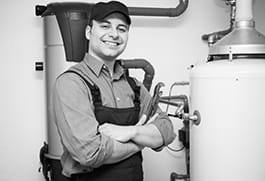Profession pipe welder

Pipe fitters assemble, install and maintain pipe systems, pipe supports and related hydraulic and pneumatic equipment for steam, hot water, heating, cooling, lubricating, sprinkling, and industrial production and processing systems.
Would you like to know what kind of career and professions suit you best? Take our free Holland code career test and find out.
Personality Type
Tasks pipe welder
- Select pipe sizes, types and related materials.
- Measure and mark pipes for cutting and threading.
- Cut, thread and hammer pipes according to specifications.
- Assemble and secure pipes, tubes, fittings and related equipment according to specifications using techniques such as welding, brazing, cementing, soldering or threading joints.
- Cut and bore holes in structures (e.g. bulkheads, decks, walls and mains) using hand and power tools.
- Attach pipes to walls, structures and fixtures using tools and equipment such as brackets, clamps or welding equipment.
- Check the work and repair and correct faults.
- Examine and test installed systems and pipe lines (e.g. using pressure gauge, hydrostatic testing, observation or other methods).
- Modify, clean and maintain pipe systems, units, fittings and related machines and equipment.
Related professions oil, gas
- Boat or derrick operator
- Boring machine operator
- First line supervisor oil or gas workers
- Gas compressor or gas pumping station operator
- Mains pipes layer-jointer
- Oil or gas geologist
- Oil or gas well driller
- Oiler, greaser
- Operator service unit oil or gas well
- Petroleum chemist
- Petroleum or natural gas refining plant operator
- Pipeline worker
- Roustabout oil or gas
- Well digger
- Well driller (not in gas and oil)
- Well service unit operator (not in gas and oil)
- Well sinker
Knowledge
- Geometry
Branch of mathematics related to questions of shape, size, relative position of figures and the properties of space.
- Health and safety hazards underground
The rules and risks affecting health and safety when working underground.
- Technical drawings
Drawing software and the various symbols, perspectives, units of measurement, notation systems, visual styles and page layouts used in technical drawings.
- Isometric perspective
Understand the isometric representation of three dimensional elements in two dimensional technical and engineering draughts for the manufacture, assembly, and maintenance of objects.
Skills
- Follow up pipeline integrity management priorities
Perform follow up on priority actions in the pipeline infrastructure, such as complete coverage, service consistency, and facilitation.
- Apply health and safety standards
Adhere to standards of hygiene and safety established by respective authorities.
- Detect flaws in pipeline infrastructure
Detect flaws in pipeline infrastructure during construction or over the passage of time such as construction defects, corrosion, ground movement, hot-tap made by error, and others.
- Use wrenches
Use spanners to adjust machinery and equipment.
- Carry out measurements of parts
Operate measurement instruments to measure parts of manufactured objects. Take into consideration specifications of manufacturers to perform the measuring.
- Cooperate with colleagues
Cooperate with colleagues in order to ensure that operations run effectively.
- Work with blacksmithing hand tools
Work with hammers, chisels, anvils, tongs, vises, forges, and others to create hand-made metal products by performing blacksmithing operations.
- Assemble manufactured pipeline parts
Assemble parts and components made for pipelines in companies or sites. Construct pipeline infrastructures or re-assemble parts that were taken out for repair. Use welding equipment and other tools in assembly activities.
- Handle chemicals
Safely handle industrial chemicals; use them efficiently and ensure that no harm is done to the environment.
- Ensure regulatory compliance in pipeline infrastructures
Ensure that the regulations for pipeline operations are met. Ensure pipeline infrastructure compliance with legal mandates, and compliance with regulations governing the transportation of goods via the pipelines.
- Operate welding equipment
Use welding equipment to melt and join together pieces of metal or steel; wear protective eyewear during the working process.
- Use metal bending techniques
Perform bending techniques in order to shape metal sheets into parts used in the manufacture of objects.
- Use rigging equipment
Set up rolling and lifting equipment required to lift and move objects e.g. with a crane or block and tackle system.
- Use measurement instruments
Use different measurement instruments depending on the property to be measured. Utilise various instruments to measure length, area, volume, speed, energy, force, and others.
- Operate soldering equipment
Use soldering equipment, such as a soldering gun, a soldering torch or a gas-powered iron, to melt and join together pieces of metal or steel.
- Use welding equipment
Operate welding equipment in a safe manner; use welding techniques such as shielded metal arc welding or flux-cored arc welding.
Optional knowledge and skills
perform follow-up on pipeline route services operate sumps rigging terminology heat metals operate hydraulic pumps cast metal join metals analyse various types of water operate oil pumping systems types of pipelines follow written instructions transport pipes security requirements of goods transported via pipelines operate forklift keep task records follow verbal instructions pipeline transport regulations; operate pumps mechanics metal and metal ore products operate pumping equipment types of metalSource: Sisyphus ODB